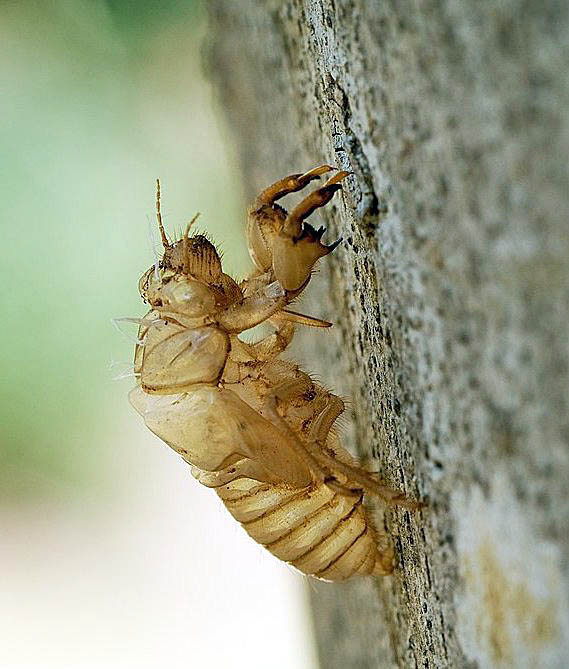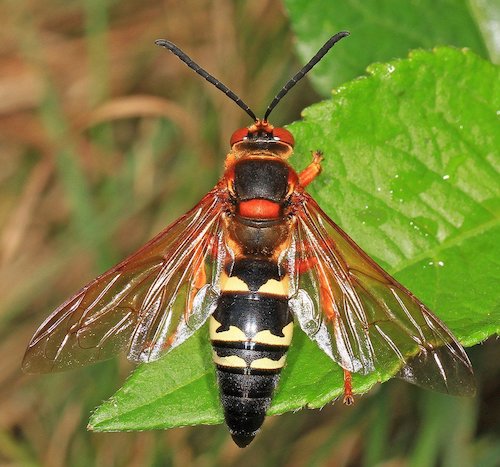Friend or Foe
The Noisy, Visible and Secret Lives of Cicadas
By Ann M. Mason, Fairfax Master Gardener

Periodical cicada
In May and June, residents in Northern Virginia will witness a phenomenon worthy of note. Each brood of cicada (Magicicada sp.) in a location will emerge in synchrony — at the same time. Yes, 2021 will be a year to jot notes in your diaries and gardening journals about the emergence of the 17-year periodical cicada. Brood 10 cicadas, last seen in 2004, are expected to emerge in numbers too great to count. They will be joined by some of our regular Dog-day cicadas, Neotibicen spp., whose broods have a two- to five-year life cycle that overlap, so we see these annually. These annual cicadas do not cause much damage.

Virginia Map of Brood 10
The emergence of Brood 10 in late May will start about four to six weeks of deafening noise as they merrily get on with the business of mating and egg laying. Our regular Dog-day cicadas can emerge in May but are more likely to emerge in June, peak in July and gradually end in August.
Let’s just call the summer of 2021 the “summer serenaded by Cicada Music!”
Where have cicadas been for 17 years? What were they doing? Let’s start with the cicadas we see. In May and early June, immature cicadas, called nymphs, will emerge from the ground. Scientists predict cicada nymphs to emerge, often after a warm rain, when the soil at 8 inches below the surface reaches 64 degrees F. As the nymphs emerge from the soil, they construct mud tubes, sometimes called cicada huts, waiting for the right conditions to crawl out of the soil. These nymphs climb on a tree or any vertical structure and molt to shed their outer brown husk (exoskeleton), which we see left behind on trees and other objects.

Cicada exoskeleton
At first, the winged, newly emerged adult is still until its wings dry out. Virginia Tech predicts the peek for this 17-year periodical cicada will be early June. Expect to hear the cacophony of chorus and mating calls of the males trying to attract a female. After mating, the female looks for ¼ to ½ inch (0.6 to 1.3 cm) pencil-width twigs, branches or vines, which she pierces with her ovipositor (egg-laying tube) and deposits eggs under the bark. It is this egg-laying process that can cause the thin branches to split, wither (called flagging damage) and often fall to the ground. A female cicada lays one to a dozen eggs at a time. She moves around to up to 50 twigs to lay approximately 400 eggs in batches.
After 6 to 10 weeks, nymphs the size of an ant hatch and drop to the ground to burrow 6 to 18 inches deep (15 to 46 cm) into the soil. These newly hatch nymphs do not feed on the twig where they hatched. Instead, they happily munch on the tree roots of the tree where mother cicada laid the eggs.
Do cicadas count the seasons to emerge in 17 years? Scientists at the University of California looked for an answer. These researchers altered the seasonal cycles of trees and observed that cicada nymphs ‘count’ the tree’s seasonal flow of xylem. In their study cicadas were not influenced by either degree days or passage of actual time. For hundreds of years, scientists have observed that some cicadas, ‘stragglers,’ emerge early, as many as four years early, which can confound the counts for other broods.
Should we kill cicadas? During June, some people might be alarmed by the number and wonder whether the cicadas will damage trees and shrubs. Young trees and shrubs with the preferred pencil-size twigs might be damaged by the female cicada’s egg-laying process. Virginia Tech does not recommend homeowners apply any pesticide because this spraying will negatively impact beneficial insects, birds and the cicada’s natural predators. Instead, Virginia Tech recommends securing netting around the tree truck to prevent cicadas from climbing to the tender twigs. To reduce the numbers of cicadas for the next brood 17 years in the future, collect the flagged and damaged twigs within six weeks of egg laying to prevent the nymphs from dropping to the ground. Gardeners can limit cicada damage on newly planted trees and shrubs by planning the planting, i.e., plant a year earlier or wait until after June 2021 to plant.
So, what natural predators might we see? Before emergence, one might see soil digging near trees. It might just be our four-footed mammal friends scouring for fat nymphs. After emergence, in addition to your resident birds, dogs, insects, racoons and some other mammals, expect to see a big wasp, the Eastern cicada killer wasp (Sphecius speciosus). These big wasps are nearly 2 inches (5 cm) long, hairy with reddish brown marking with light yellow strips on the abdomen and reddish black thorax.

Cicada killer wasp
The eastern cicada killer wasp is a solitary digger-type wasp. The female nests underground in loose soil, including sand and garden soil. They do not like moist soil, which is a deterrent to their building nests. While female cicada killer wasps can sting, they are focused on building nests and capturing and paralyzing cicadas to nourish their developing larvae. Males cannot sting but often buzz menacingly around people using noisy machines, like lawnmowers.
There are no reported sightings of Asian giant hornets (Vespa mandarinia), in the Mid-Atlantic region, including Pennsylvania, Maryland, Virginia, District of Columbia and North Carolina. Colonies found in Washington state were eliminated, and extensive monitoring for the presence and immediate control of these hornets are in place.
Are you up to the challenge to identify the specific species of cicada you see? In our area, you might be able to discern which of the three Magicicada species visits your neighborhood by comparing the sound captured by scientists at Insect Singers (links below) to the chorus and mating sounds you hear. This is a great time to put those nature observation skills to work.
Resources
• What’s that noise? The 17-year cicadas are back, Virginia Tech Daily, May 2020
• Periodical Cicada, Virginia Cooperative Extension, Publication 444-276
• The 2021 Periodical Cicada Emergence (Brood X), University of Connecticut
• Cicadas of the United States and Canada, East of the 100th Meridian, University of Connecticut in the
lab of Chris Simon. Specifically, the sound links to the three Brood 10 species are:
Magicicada cassinii
Magicicada septendecim
Magicicada septendecula